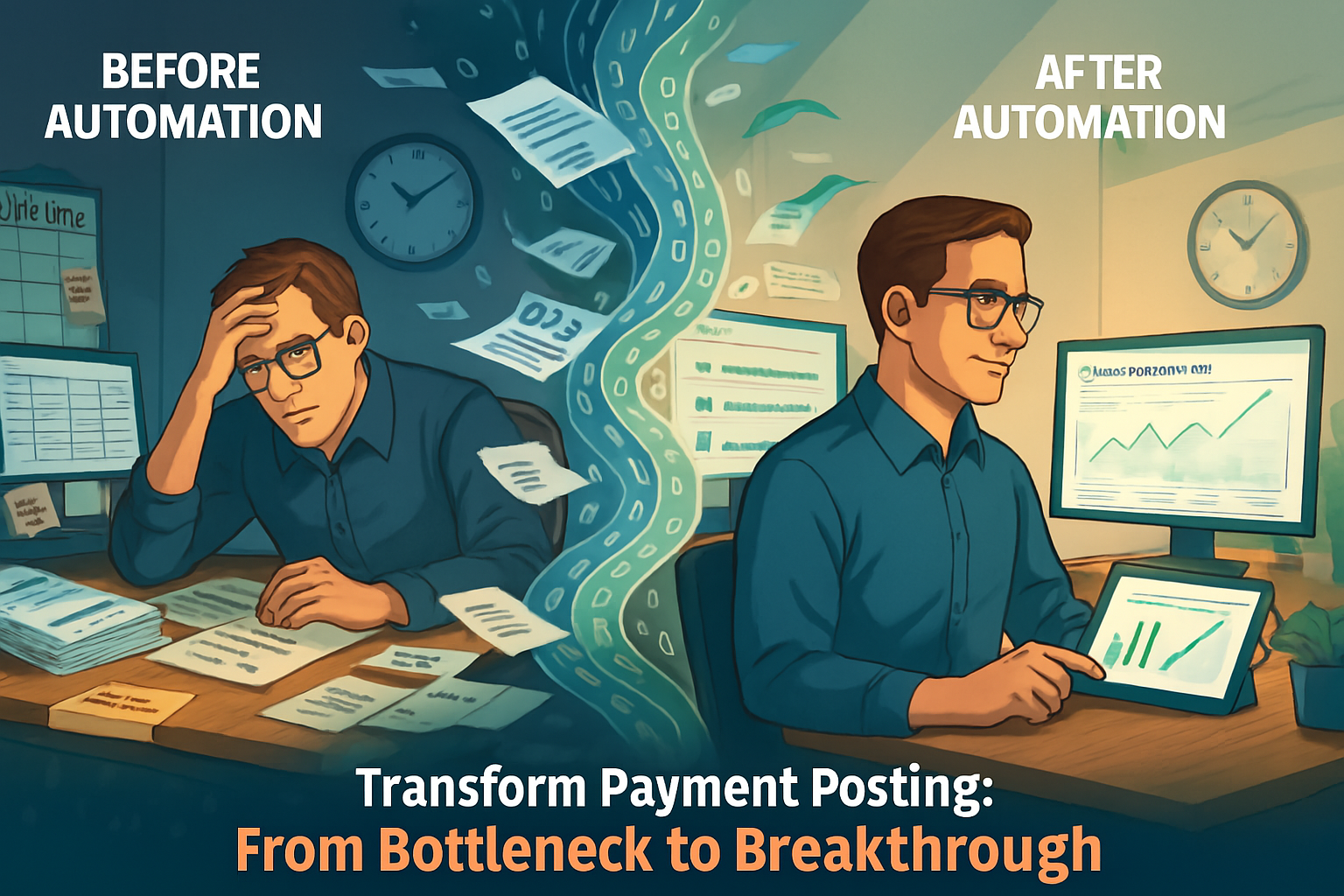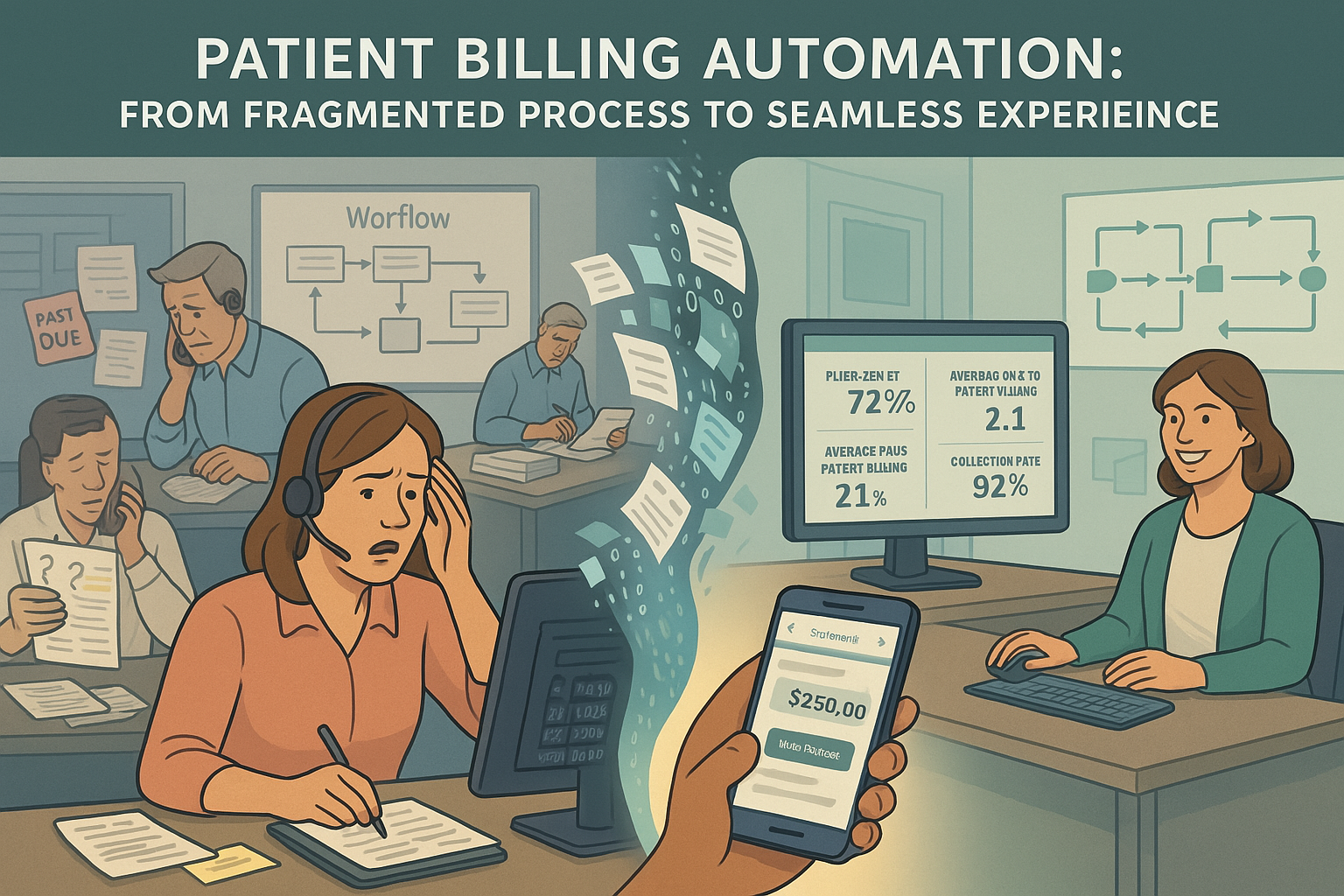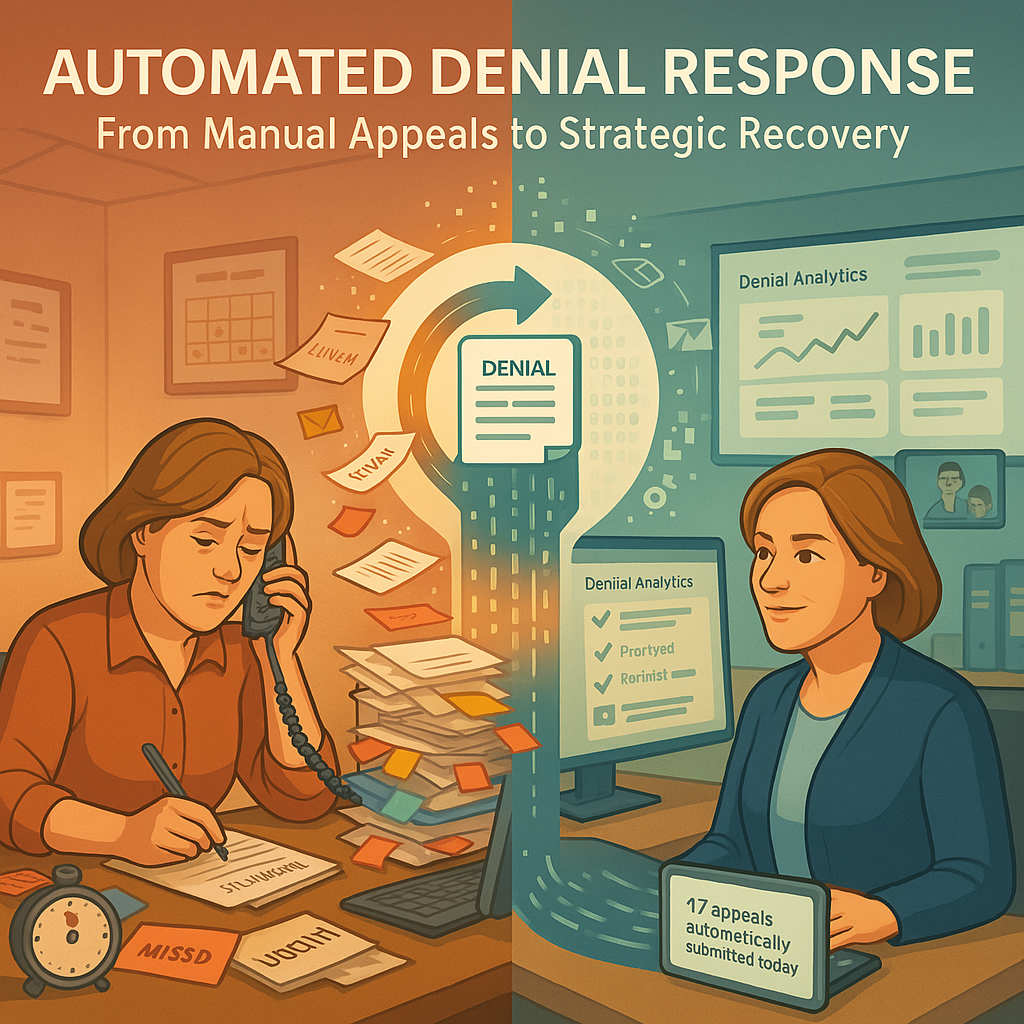In today’s healthcare financial landscape, the bottleneck between receiving payment information and initiating follow-up actions remains one of the most persistent challenges for revenue cycle leaders. Despite advances in technology, many organizations still dedicate significant resources to the manual processing of 835s, EOBs, and payment reconciliation—creating delays that cascade throughout the entire revenue cycle.
The Hidden Cost of Manual Payment Posting
For most revenue cycle operations, the current workflow involves staff dedicated to retrieving 835s from clearinghouses, performing reconciliation steps, applying payments at the account level, validating allowed amounts, triaging denials, transferring balances, and ensuring adjustment integrity. These activities, while necessary, create several operational challenges:
- Resource intensity: Skilled staff spending hours on repetitive tasks. The frustration of watching your most capable team members consumed by data entry rather than solving complex revenue issues is both financially and culturally draining.
- Workflow bottlenecks: Delays between payment receipt and subsequent billing actions. Few things are more aggravating than knowing secondary claims and patient statements are sitting idle while payments await posting—especially when timely filing deadlines loom.
- Accuracy issues: Manual errors in payment application and balance transfers. The inevitable human errors that occur during manual posting create downstream chaos that often takes more time to correct than the original posting process itself.
- Delayed denial management: Critical follow-up actions postponed by processing backlogs. The helpless feeling of watching denial response windows shrink while payments await processing represents one of the most avoidable sources of write-offs in the revenue cycle.
- Limited cash flow visibility: Difficulty tracking payment status across accounts. The inability to provide accurate cash projections to leadership creates tension between revenue cycle and finance departments that undermines organizational trust.
The manual nature of these processes doesn’t just drain resources—it fundamentally limits how quickly your organization can respond to payment outcomes and initiate the next appropriate action.
Comprehensive Automation Framework
Our payment posting automation solution addresses these challenges by transforming the backend of your revenue cycle with a multi-layered approach:
1. Data Synchronization Foundation
The system maintains a complete mirror of your EHR transaction ledger alongside incoming payment information from insurance companies. This dual-source data foundation enables intelligent decision-making about what actions to take on each account. Gone are the days of manually toggling between systems to reconcile discrepancies, a process that leaves staff exasperated and introduces needless opportunities for error.
2. Intelligent Payment Processing
For both electronic 835s and scanned EOBs, the system:
- Analyzes payment data against expected outcomes
- Identifies appropriate posting actions for each transaction
- Prepares structured input for the posting automation
- Executes appropriate adjustments based on payment outcomes
The relief of eliminating the monotonous daily grind of manual EOB and 835 processing cannot be overstated. Staff no longer face the mind-numbing task of interpreting cryptic payment codes and translating them into system actions, a process that drains morale and leads to burnout among your most detail-oriented team members.
3. Optional Bank Reconciliation Layer
For organizations requiring enhanced financial controls, the solution can incorporate deposit log data to:
- Match received 835s to corresponding bank deposits
- Reconcile zero-pays and recoupments appropriately
- Ensure financial integrity across all payment channels
- Provide verification of complete payment processing
The monthly reconciliation headaches between finance and revenue cycle departments become a thing of the past. No more contentious meetings attempting to explain discrepancies between bank deposits and posted payments—a process that typically consumes days of effort and creates interdepartmental tension with little strategic value.
4. Recoupment Management
The system automatically:
- Identifies recoupments within payment files
- Links them to source accounts and original claims
- Segregates these accounts for proper handling
- Ensures recoupments are properly documented rather than “swept under the rug”
The all-too-common scenario of discovering six-month-old undocumented recoupments during an audit becomes obsolete. Few experiences in revenue cycle management are more infuriating than uncovering historic recoupments that were never addressed, leaving both money on the table and creating compliance risks that could have been easily mitigated with proper tracking.
5. Allowable Verification
Through integration with fee schedules and contract management data, the system performs:
- Verification of allowed amounts against expected values
- Identification of potential underpayments
- Documentation of discrepancies for follow-up
- Acceptance of payments within configurable tolerance ranges
The perpetual challenge of catching underpayments amid thousands of transactions no longer depends on staff vigilance or random audits. Revenue cycle leaders know the particular frustration of discovering significant underpayments months after they occurred—when appeals deadlines have passed and recovery options are limited or nonexistent.
Denial Triage and Next-Best-Action Intelligence
Beyond payment posting, this automation delivers critical intelligence about denials:
- Automatic classification of denials by type and root cause
- Assignment of appropriate next actions for each denial
- Routing to the appropriate workflow or staff member
- Data collection to inform upstream claim scrubbing improvements
This intelligence becomes the foundation for downstream automation initiatives, creating a continuous improvement feedback loop that progressively reduces denial volumes.
The chronic pain of having denials sit unworked in generic work queues—or worse, having them misrouted to inappropriate teams—creates unnecessary friction and delays. Few things cause more operational angst than discovering high-value denials that have aged beyond appeal deadlines simply because they weren’t identified and routed properly when first received.
Strategic AR Cleanup Integration
A crucial aspect that many automation solutions overlook is the importance of account cleanup. Our approach begins with a strategic cleanup initiative to:
- Identify and resolve aging accounts with small balances
- Correct misapplied adjustments from previous transactions
- Resolve invalid credits and improperly logged recoupments
- Establish a clear picture of true active AR
This cleanup is not just a preliminary step—it’s essential for ensuring automation accuracy and preventing the perpetuation of existing errors.
The persistent irritation of having your AR metrics distorted by legacy accounts and small balances creates both reporting headaches and operational inefficiencies. The disheartening reality of hundreds or thousands of accounts requiring more effort to resolve than they’re worth financially creates a perpetual backlog that clouds true performance metrics and creates artificial work that distracts from higher-value activities.
Daily Operational Cadence
The automation operates on a consistent daily schedule:
- Overnight processing of all incoming payment data
- Complete reconciliation and posting before the start of business
- Morning delivery of payment reconciliation reports
- Triage of denials into appropriate work queues
- Staff ready to begin working prioritized follow-up actions immediately
This cadence eliminates the traditional lag between payment receipt and action, accelerating the entire revenue cycle.
The constant pressure of playing catch-up with payment posting—and the scramble that ensues when key staff are absent—creates unnecessary stress throughout the revenue cycle. Few operational scenarios are more frustrating than arriving to find a backlog of unposted payments that delay all downstream activities, creating a cascade of inefficiency that can take days or weeks to resolve.
Staff Transformation Opportunities
With payment posting automation, your current staff can be redirected from manual data entry to higher-value activities:
- Focused denial management and appeals
- Proactive claim quality improvement
- Payer relationship management
- Financial counseling and patient collections
- Complex account resolution
The shift represents not just a reduction in routine work, but an opportunity to deploy your team’s expertise where it delivers the greatest financial impact.
The talent waste of having skilled revenue cycle professionals spending their days on manual data entry creates both operational inefficiency and employee dissatisfaction. The demoralizing experience of highly capable staff performing repetitive tasks well below their capability level leads to turnover and disengagement—particularly frustrating when you know their skills could be applied to revenue-generating activities instead of administrative maintenance.
Implementation Considerations
For experienced revenue cycle leaders considering this automation, key implementation factors include:
- System integration approach: Direct EHR integration vs. data extraction methods
- Historical data migration: How far back to analyze for cleanup opportunities
- Posting rules customization: Adapting to your specific adjustment codes and workflows
- Verification thresholds: Setting appropriate tolerance levels for allowed amount variance
- Staff transition planning: Preparing your team for new responsibilities
Successful implementations typically see full automation operational within 60-90 days, with preliminary cleanup initiatives beginning to show impact within the first 30 days.
Performance Metrics and ROI
Organizations implementing payment posting automation typically experience:
- 90-95% reduction in manual posting time
- 24-48 hour acceleration in denial identification and response
- 15-20% improvement in cash application accuracy
- 3-5% increase in net collections through improved denial management
- 30-40% reduction in days in A/R for denied claims
These metrics translate to both immediate operational savings and downstream revenue enhancement through accelerated cash flow and reduced write-offs.
Conclusion
Payment posting automation represents the critical first step in a comprehensive revenue cycle transformation. By establishing intelligent automation at the intersection of payment receipt and account management, you create both immediate operational benefits and the foundation for additional automation initiatives. The visibility gained into payment patterns, denial trends, and payer behavior becomes the knowledge engine that powers further improvements throughout your revenue cycle.
In our next article, we’ll explore how the insights gained from payment posting automation drive our second roadmap component: 360-degree claim scrubbing to prevent denials before submission.




